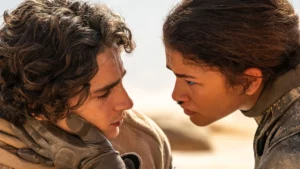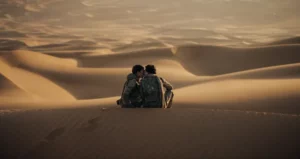Dune: Part Two (2024) review
Dir. Denis Villeneuve
By: Steve Pulaski
Rating: ★★★
If Dune left any doubt, Denis Villeneuve’s follow-up confirms this is the most ambitious cinematic series since Peter Jackson’s Lord of the Rings trilogy.
Following decades-long belief from some of the medium’s most accomplished directors that a faithful adaptation of Frank Herbert’s lofty sci-fi series was “unfilmable,” Villeneuve has disproven that twice over in profound fashion. While I’d be hard-pressed to explain the finite details of the series, there is something stirring about seeing a modern blockbuster that feels as grandiose as this one — perhaps due to the fact that films intent on setting up impossibly large worlds can easily prompt disappointment and unrealized potential. As I did with Villeneuve’s predecessor, at a certain point with Dune: Part Two, I stopped trying to understand the innerworkings and just let myself be immersed in it all, which is always a great feeling when going to the theater.

Dealing with everything from mysticism to the meaning of hallucinogenic visions, Dune: Part Two picks up where the first film left off, with Duke Paul Atreides (Timothée Chalamet) and his pregnant mother (Rebecca Ferguson) seeking refuge with the Fremen following the attack on House Atreides by House Harkonnen. Stilgar (Javier Bardem), one of the Fremen leaders, becomes a mentor to Paul by showing him how the desert people live. Eventually, the Fremen become entangled in the ongoing war with the Harkonnens, led by the Baron (Stellan Skarsgård) and his nephews, Glossu Rababan (Dave Bautista) and Feyd-Rautha (Elvis‘ Austin Butler looking like the creature from Splice).
The war is over the invaluable resource known as “spice,” the highly addictive powder that can increase life expectancy, provide a heightened sense of awareness, and unlock psychic powers. The conflict between Atreides, the Fremen, and the Harkonnens attracts the attention of the Emperor (Christopher Walken), who arrives with his daughter, Princess Irulan (Florence Pugh) and his own troops as well. Also complicating Paul’s journey is his relationship with Chani (Zendaya), their union not a forgone conclusion as the first film might’ve suggested.
Where Dune meticulously laid the foundation for the setting and its inhabitants, Villeneuve and co-writer Jon Spaihts permit themselves more liberty to play with the sequel. There are no better sequences in the film than the ones featuring the popular sandworms, which come roaring into the narrative in a thrillingly dynamic scene where Paul battles hurricanic winds in order to glide on the back of one. Cutting edge visual technology and sound armed with the ability to make your seat rumble initiate what is sure to be one of the most unforgettable sequences of the year.

Comparisons will be made, most notably to The Empire Strikes Back. Dune: Part Two reminded me a lot of Avatar: The Way of Water in how it takes us to a completely different area of its large world. In Cameron’s sequel, we were introduced to the Metkayina reef people, and the significance of water in the world of Pandora. In Villeneuve’s sequel, we learn the ways of the Fremen, and the previously unforeseeable bond between them and Atreides is predicated on desperation and helplessness, emotions deeply embedded in the story.
Villeneuve takes time to introduce new characters instead of dropping them into the fold to leave us with the task of figuring out their significance. The best of the lot is Feyd-Rautha, whose dark backstory is illustrated in a lengthy black-and-white sequence followed by a terrifyingly brutal gladiator battle with his uncle watching from the rafters. Butler’s feral turn as the psychopathic creature is an engrossing, chameleon-like performance that demands your attention.

That said, the weak link remains Chalamet, although Paul is given more depth and along with moralistic complications of loyalty and leadership. Chalamet is still too opaque for his own good, and his character feels like another iteration of “the chosen one” trope ala Anakin Skywalker (which, given the impact Frank Herbert’s novels had on Lucas, it does prompt a strange “chicken vs. egg” sidebar debate). Everyone from Zendaya to Skarsgård is up to the task, but like I opined after watching the first film, the themes and dense world-building yet again smother a lot of the potential charisma of the cast, although Bardem, like Jason Momoa in the first film, commendably offers some comedic relief.
One can’t accuse Dune: Part Two of being empty calorie eye candy at the very least. It does what an epic sequel should by furthering the story, inviting larger stakes, and increasing the intensity. Greig Fraser’s desert cinematography, in conjunction with Hans Zimmer’s score, converge to create a setting that’s gorgeously haunting for its vastness and danger. Villeneuve has flexed his filmmaking muscles so far that not seeing this trilogy completed would be seen as an affront to an auteur at the height of his game. It doesn’t take a Herbert scholar to appreciate Dune for what it is to cinema: an achievement that defies odds.
NOTE: Dune: Part Two is now playing exclusively in theaters.
Starring: Timothée Chalamet, Zendaya, Rebecca Ferguson, Josh Brolin, Austin Butler, Florence Pugh, Dave Bautista, Christopher Walken, Léa Seydoux, Stellan Skarsgård, Charlotte Rampling, and Javier Bardem. Directed by: Denis Villeneuve.
About Steve Pulaski
Steve Pulaski has been reviewing movies since 2009 for a barrage of different outlets. He graduated North Central College in 2018 and currently works as an on-air radio personality. He also hosts a weekly movie podcast called "Sleepless with Steve," dedicated to film and the film industry, on his YouTube channel. In addition to writing, he's a die-hard Chicago Bears fan and has two cats, appropriately named Siskel and Ebert!


